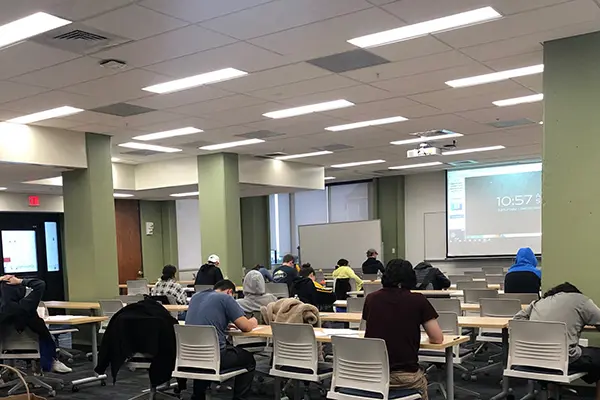Mathematical Problem-Solving Course Prepares Students for the Challenge
 Image by Kenneth Levasseur
Image by Kenneth Levasseur
12/19/2022
By Brooke Coupal
Armed with pencils and plenty of scrap paper, 19 students gathered in an Olsen Hall classroom, ready to take on the toughest college math competition in North America.
The William Lowell Putnam Mathematical Competition, which was launched in 1938, takes place on the first Saturday of December and is open to undergraduate college students in the United States and Canada. For the past seven years, Mathematics and Statistics Prof. Kenneth Levasseur has supervised the competition at UMass Lowell.
“The competition challenges students and gives them an opportunity to integrate different areas in math,” he says.
The Putnam Competition, which must be completed without the aid of technology or calculators, is broken into two three-hour sessions with six questions given during each session. The questions are notoriously difficult, with students scoring, on average, zero to two points out of 120.
Senior mathematics major Sam Colby was initially daunted by the competition. However, Levasseur’s Mathematical Problem-Solving course gave him the confidence to compete.
“The course prepared me for everything that I needed to do on the Putnam, but in a very low-stress environment,” he says.
Colby was one of 17 undergraduate students from Mathematical Problem-Solving who participated in the Putnam Competition, which is a course requirement. Two other UML undergraduates from outside the course also competed.
Each week in class, Levasseur went over a different math discipline, including geometry, algebra, calculus, polynomials, tricks of the trade and sequences and series, to help the students prepare.
 Image by Brooke Coupal
Image by Brooke Coupal
“We used past examples of the Putnam Competition as practice problems, and that helped a lot,” says Tanya Kieu, a junior honors mathematics major from Woburn, Massachusetts.
As the students improved their problem-solving skills, they also learned the importance of communicating how they came to their solutions.
“It’s one thing to know the answer, but it’s another thing to make it clear to other people how you got that answer,” says Levasseur, who emphasized that a student could have the right answer to a Putnam question, but unless they showed how they got that answer, they would not get a perfect score.
Colby, who’s from Manchester, New Hampshire, enjoyed the discussion-based format of the course.
“We could experiment a lot with different ways of problem-solving and then discuss the solutions that we got,” he says. “It made math really engaging.”
The solutions to this year’s Putnam Competition are available online, but students will not know their official results until late February, as it takes time for the graders to look over each participant’s work. Cash prizes are awarded to students with the highest scores and to the five institutions whose teams obtained the highest rankings.
Rebecca Mendum, a junior mathematics major who took part in the competition, says no matter what score she gets, she took away a valuable lesson.
“I learned how persistent I can be in my math problem-solving,” says the Framingham, Massachusetts, resident. “Eventually, I want to solve a new problem that nobody else has solved before.”
